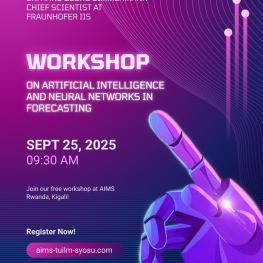Start
25. September 2025 - 9:30
End
25. September 2025 - 15:00
Address
AIMS Rwanda, Kigali View mapOverview
Artificial Intelligence is an integrated framework of perception, modeling, and action planning. In this tutorial we will focus perception on multi-dimensional time series, work out the mathematics of neural networks as a modeling framework and finally ask how to use such models in action planning. A focus on decision support must imply risk analysis as an important challenge. The tutorial not only introduces a set of mathematical techniques but trains a thinking style which balances the handling of data and first principles.
Let’s assume that we must solve a customer forecasting project. The target variables which we must forecast are given. But which supporting input variables should we use: sometimes the set of available indicators is overwhelming. Beside expert knowledge the question arises in which way mathematics can help us to sort out this problem. First, we should be aware that the relevance of inputs depends on the chosen modelling framework. If you start with a linear framework, one might oversee nonlinear input-output relationships (e.g. this situation shows up especially if you use a simple correlation test as a setup step before you do the modelling). The opposite situation could be that you are aware of important inputs, but you have no chance to get learning data. Here the underlying mathematical question is to specify models which are able to reconstruct hidden variables.
If we do not have reasons to believe in special interrelationship between the variables we should start with a universal approximation framework, e.g. neural networks. This does not mean that we want to roll over the burden of the model building completely to the data, but we are free to integrate reasonable first principles explicitly in the model building (e.g. monotonicity…). In forecasting, time is obviously the dominant structure which leads to recurrent neural networks (RNNs). Transformer networks as an alternative are basically feedforward networks and are more data hungry than RNNs. We will start from RNNs as delayed input-output structures, extend to error correction nets to have a first chance to include missing inputs. Further analysis is on the dynamical inconsistency of these networks between past and future: in the past we assume that external inputs are important, in the future we do not have such information. Another well-known problem for RNNs is the long memory modelling. I will show that LSTM is only one possible answer to this question. Further interesting extensions are dynamical systems on manifolds – such nets are especially important for load forecasting. Another way to exploit the redundancy of target variables is global modeling – which RNNs fit to this extension? An even more sophisticated question is forecasting models which include the future expectations of agents in a market. Beside causal- this includes retro-causal information flows. The key to an understanding of the above tasks is in network architectures and not so much in algorithms.
In many economical applications we have relative short training series given the complexity of the underlying dynamical system of interest. If one insists on model flexibility one has to work with underdetermined models. This has consequences for the learning as well as the modeling of noise, uncertainty and a following decision support.


